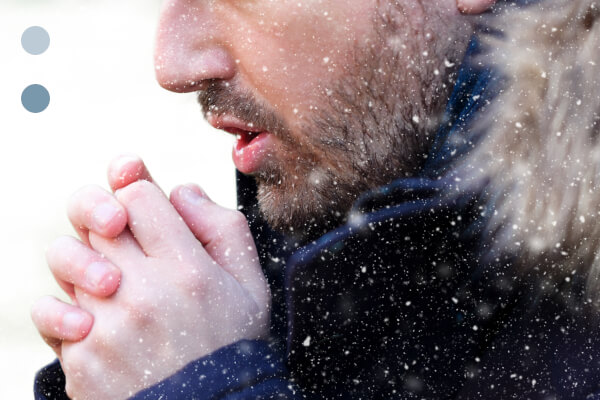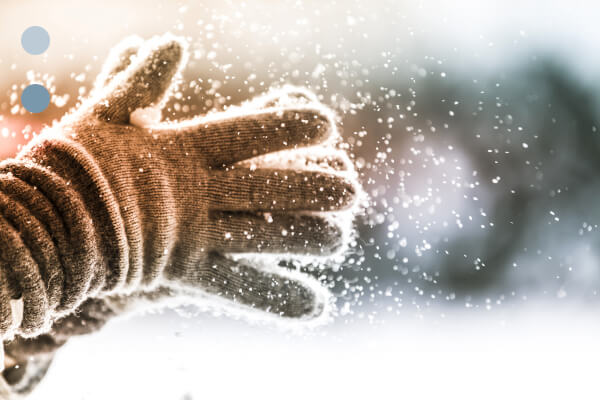
Good to know:
Dry hands in fall and winter
Good to know:
Dry hands
in fall and winter
Rough weather, rough hands?

During the fall and winter months, dry hands quickly become a permanent state. The skin as a whole is exposed to extreme conditions during this time – but especially on the hands, since they are usually directly subjected to environmental influences such as cold, dry heating air, and even more frequent hand washing.
The result is brittle, rough hands. Often, however, it is not just this unpleasant feeling: dry hands are also more susceptible to inflammation, cracks and even eczema. Cracks and open areas also make it much easier for pathogens to enter the body directly.

Rough weather, rough hands?

During the fall and winter months, dry hands quickly become a permanent state. The skin as a whole is exposed to extreme conditions during this time – but especially on the hands, since they are usually directly subjected to environmental influences such as cold, dry heating air, and even more frequent hand washing.
The result is brittle, rough hands. Often, however, it is not just this unpleasant feeling: dry hands are also more susceptible to inflammation, cracks and even eczema. Cracks and open areas also make it much easier for pathogens to enter the body directly.

Cold weather: Poor conditions for the skin's natural protective mechanisms
For people who struggle with dry hands all year round, the condition of the skin often worsens as temperatures drop. But even those who were spoiled with smooth skin on their hands throughout the summer can suddenly experience problems. But what’s the reason for this?
Sebaceous glands provide moisture for the skin. They produce the necessary lipids to protect the skin from drying out. In cold weather, however, this production is reduced – and that already starts at temperatures below 10°C.
Since there are fewer sebaceous glands in the thin skin on the back of the hands anyway, and none at all in the palms, the hands suffer particularly quickly from dry skin. Dry heating air also draws additional moisture from the hands. Even more frequent hand washing to protect against germs during the cold season attacks the natural skin protection layer on the hands, as well.

Cold weather: Poor conditions for the skin's natural protective mechanisms

For people who struggle with dry hands all year round, the condition of the skin often worsens as temperatures drop. But even those who were spoiled with smooth skin on their hands throughout the summer can suddenly experience problems. But what’s the reason for this?
Sebaceous glands provide moisture for the skin. They produce the necessary lipids to protect the skin from drying out. In cold weather, however, this production is reduced – and that already starts at temperatures below 10°C.
Since there are fewer sebaceous glands in the thin skin on the back of the hands anyway, and none at all in the palms, the hands suffer particularly quickly from dry skin. Dry heating air also draws additional moisture from the hands. Even more frequent hand washing to protect against germs during the cold season attacks the natural skin protection layer on the hands, as well.

Intensive care for dry hands in winter
Caring for the hands with mild, pH-neutral soap and appropriate creams makes sense all year round. In autumn and winter, however, when other environmental influences come into play, the skin needs particularly intensive treatment.

- Gloves ensure that the hands stay warm and that the function of the sebaceous glands doesn’t shut down further.
- Thin cotton gloves can also help at night, namely when a particularly fatty cream is applied underneath so that it can be fully absorbed overnight.
- An oil bath also provides relief. For this, a few drops of oil, for example olive, coconut, or almond, are put into a small bowl together with lukewarm water. The hands are then held in the hand bath for 10 to 15 minutes.
- For very dry hands, you can resort to a plain oil bath made of pure olive oil to make the skin soft and smooth again.
Intensive care for dry hands
in winter

Caring for the hands with mild, pH-neutral soap and appropriate creams makes sense all year round. In autumn and winter, however, when other environmental influences come into play, the skin needs particularly intensive treatment.
Gloves ensure that the hands stay warm and that the function of the sebaceous glands doesn’t shut down further.
Thin cotton gloves can also help at night, namely when a particularly fatty cream is applied underneath so that it can be fully absorbed overnight.
An oil bath also provides relief. For this, a few drops of oil, for example olive, coconut, or almond, are put into a small bowl together with lukewarm water. The hands are then held in the hand bath for 10 to 15 minutes.
For very dry hands, you can resort to a plain oil bath made of pure olive oil to make the skin soft and smooth again.
Skin care for winter: Natural fats and oils for sustainable protection
For healthy and smooth hands in autumn and winter, it is especially important to take care of the sensitive skin area regularly. It is therefore advisable to always have some hand cream with you for in-between hand care.
But like the rest of your daily skin care, the choice of cream should be adapted to the season. While lighter products can suffice in summer, the skin is better supported in winter by creams with a high oil or fat content.


To provide dry hands with lasting moisture and to strengthen them from the inside out, the skin needs more than just moisturizers: natural ingredients are now particularly important. Synthetic substances such as silicones may make the skin appear smoother and softer for a short time, but they wash off just as quickly.
Natural oils and fats, such as olive oil, shea butter or argan oil, on the other hand, are moisturizing and compensate for the missing lipids. In addition, they not only form a protective shield on the skin, but also strengthen and regenerate the sensitive skin from the inside in the long term.
Skin care for winter: Natural fats and oils for sustainable protection

For healthy and smooth hands in autumn and winter, it is especially important to take care of the sensitive skin area regularly. It is therefore advisable to always have some hand cream with you for in-between hand care.
But like the rest of your daily skin care, the choice of cream should be adapted to the season. While lighter products can suffice in summer, the skin is better supported in winter by creams with a high oil or fat content.

To provide dry hands with lasting moisture and to strengthen them from the inside out, the skin needs more than just moisturizers: natural ingredients are now particularly important. Synthetic substances such as silicones may make the skin appear smoother and softer for a short time, but they wash off just as quickly.
Natural oils and fats, such as olive oil, shea butter or argan oil, on the other hand, are moisturizing and compensate for the missing lipids. In addition, they not only form a protective shield on the skin, but also strengthen and regenerate the sensitive skin from the inside in the long term.

